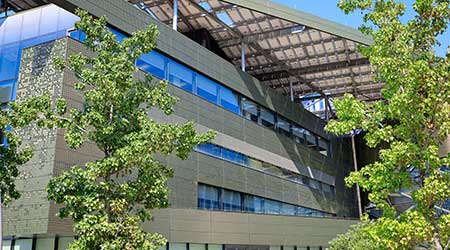High-performance HVAC Systems Help GSA Reduce Energy Consumption
In many cases, HVAC systems are being transformed into high -performance designs. But there are many ways that HVAC systems can reach that goal of high performance. In the Edith Green-Wendell Wyatt Federal Building, for example, a hydronic radiant heating and cooling system is expected to work with the other energy savings measures to reduce the building's overall energy consumption between 60 and 65 percent.
In three federal buildings in Chicago — 10 West Jackson, 18 West Jackson and 230 South State — modern HVAC systems are being installed that use occupancy and carbon dioxide sensors.
Geothermal ground wells are the story at the Bishop Henry Whipple Federal Building in Fort Snelling, Minn. The installation is expected to be more than 30 percent more efficient than ASHRAE baseline standards for HVAC and more than 70 percent more efficient than traditional electric heating and air conditioning systems. With that system, plus a high-efficiency lighting system, the 618,000-square-foot facility is hoping for LEED Gold certification when completed in 2014.
A much smaller project, the new 33,000-square-foot U.S. Courthouse in Bakersfield, Calif., is the first courthouse in the country to use chilled beam technology to cool the building. More popular in Europe and Australia, chilled beam technology benefits from a lower operating cost because the temperature of chilled water is higher for the same amount of cooling. Because they are transferring cooling down from the ceiling beams, the system uses fewer air circulating fans at lower speeds.
Chilled beams also are nearly noiseless, require little maintenance and are very efficient. The Geonomic Science Building at the University of North Carolina at Chapel Hill, for instance, lowered its HVAC costs by 20 percent with an active chilled beam system.
3. Smarter Lighting
In the lighting arena, the focus is on relighting projects, not just relamping with more efficient lamps and ballasts. Relighting projects involve new fixtures using high-performance lamps and ballasts, plus new fixture locations to take advantage of high performance light distribution. In addition, the projects use lighting controls, including personal controls in some cases.
Another approach is the use of direct/indirect pendant lighting fixtures in continuous rows to provide room surface brightness. When task lighting is provided, light levels can be reduced slightly. That saves energy, as does use of the newest technology and the need for fewer fixtures. GSA has found that daylighting controls should be integrated into this solution in perimeter zones.
GSA has also been exploring intelligent workstation-specific fixtures with constant indirect lighting and personally controlled downlights. Those features, along with occupancy sensors, daylight dimming, peak load demand response and the need for fewer fixtures, can contribute to significant energy savings. What's more, GSA found such workstations resulted in a 20 percent improvement in occupant comfort. With these systems, it's important to plan carefully for commissioning and maintenance.
Changes to the lighting system aren't the only way to increase lighting energy efficiency, GSA has found. Using ceiling, wall, and floor reflectances effectively in a space permits significantly more light from the same amount of energy. For example, increasing ceiling reflectance from 80 percent to 90 percent, and boosting reflectance on walls from 25 percent to 60 percent, increased average footcandles from 16 to 28.
Related Topics:














